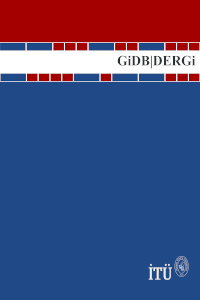YÜZEN MİMARİ TASARIM SÜREÇ MODELLEMESİNDE KURAL TABANLI KARAR VERME DESTEK MODELİ
Suyu, mimari tasarımda yapının yerleştiği alternatif tasarım alanı olarak düşündüğümüzde getirdiği fırsatlar; yeni fonksiyonlar için tasarım yapılmasına ve yüzen yerleşim oluşturma potansiyelinin değerlendirilmesine olanak sağlamasıdır. Bu çalışmada yüzen bir yapının mühendislik tasarımının yanında, mimari tasarım sürecini etkileyen koşullar incelenmiştir. Yüzen mimari yapıya etkiyen rüzgâr ve dalganın, kullanıcı konforunu azaltacak hareket etkilerinin ortaya çıkmasına neden olduğu görülmüştür. Çalışmada bu etkiler, yüzen mimari tasarım sürecinde aktif tasarım öğesi desteği olarak kullanılmıştır. Çevresel sınır koşullarını oluşturan rüzgâr ve dalganın, meydana getirdiği yanal yüklerin yüzen yapıya etkidiği noktadan, yapının bağlandığı zemine kadar olan aktarımı sürecinde meydana getirdiği yapı salınım hareketini oluşturan öncelikli etmenler, yapısal bütünlük açısından belirlenmiş, uzman sistemlerden yararlanarak değerlendirilmiş, yapıya etki derecesi kural tabanı haline dönüştürülmüş ve geliştirilen yöntemin yüzen mimari yapı tasarım süreci içinde yer alan yapı boyutlandırması aşamasında, yeni bir karar verme destek modeli önerisi olarak sunulması amaçlanmıştır. Kural tabanlı karar destek sistemi olarak bulanık mantıktan yararlanılmıştır. Yüzen yapı hareketini etkiyen dalga yüksekliği ile yapının borda yüksekliği, dalga uzunluğu ile dik geldiği yapı kenar boyutu ve rüzgâr hızı ile etkilediği üst yapı alanı arasındaki ilişkiler uzman kararı ile kurallar haline getirilmiştir. Dalga-rüzgâr etkisi altındaki yüzen mimari yapının, yapı tasarım süreci modellemesi için önerilen kurallar, ‘Matlab’ programı içinde kullanılmıştır. Yüzen mimari yapı tasarımında yeni ürün modellemesi sürecinde uzman karar destek sistemi kullanılmış, geliştirilen kural tabanı Matlab içinde uygulanmıştır
Anahtar Kelimeler:
Yüzen mimari, süreç modelleme, kullanıcı konforu, kural tabanı, bulanık mantık
The intention of the study is to discuss the information about floating structures, then with the cooperative assistance of fuzzy logic, compose a ruled-based decision support method. The environmental conditions, user comfort vibration performance parameters and structure dimensions are converted into simple linguistic variables using fuzzy logic, providing a tool to help the designer to see all the possible set of solutions to meet the required objectives set by the designer. Motion effects causing vibration on human biodynamics discussed under the environmental parameters, with expert system approach, all frame the rule-based decision support model. The tool for analyzing data is fuzzy logic which works with linguistic variables within the decision support systems for evaluating design modeling with site-specific environmental data and recent research data of floating structures. Rule-bases formed in the study with three input parameters and an output is formed with expert view. With the support of expert view these general rule bases would be decreased into basic rule bases. In the concept design modeling step of floating architecture, the extreme flexibility, due to learning ability and the capability of nonlinear function of approximations of fuzzy logic makes the proposed model to be an appropriate tool for solving the motion characteristics of floating architectures user comfort needs, while overcoming complexity and non-linearity associated with wave-wind interaction. Human decision maker is setting the criteria, fuzzy logic linguistic variables provide optimal rule-bases for these parameters, after getting the solutions the decision-maker modifies the dimensions of the structure and so on, until a desired solution matches the designer’s complete preferences
Keywords:
Floating architecture new product modeling, rule base, fuzzy logic, process modeling, user comfort,
___
- Ayça Tartar, Doktora Tezi, İstanbul Teknik Üniversitesi / Fen Bilimleri Enstitüsü / Mimarlık Anabilim Dalı / Yapı Bilim Dalı, 2012.
- Aouad, G., Hinks, J., Sheath, D., Cooper, R., Kagioglou, M. (1998). An IT map for a generic design and construction process protocol. EPSRC IMI Generic Design & Construction Process Protocol (pg.14).
- Chen, W. (2009). The stability of an oceanic structure with T–S fuzzy models, Mathematics and Computers in Simulation 80 (2009) 402-426, Elsevier
- Colwell, J. L. (1989). Human Factors in the Naval Environment: A Review of Motion Sickness and Biodynamic Problems. DREA Technical Memorandum 89/220, Dartmouth: Canadian National Defence Research Establishment Atlantic
- Cooper, R., Lee, A., Wu, S., Fleming A., and Kagioplu M. (2005). Process Management in Design and Constrcution, Blackwell Publishing, Dubois, D. (2009). A Unified View of Uncertainty Theories- Fuzzy Systems Association World Congress and 2009 European Society for Fuzzy Logic and Technology Confrence ( IFSA-EUSFLAT 2009 )
- Flachbart, G., and Weibel P. (2005). Disappearing Architecture, From Real to Virtual to Quantum, Birkhuser – Publishers of Architecture Basel- Boston- Berlin (pp. 61).
- Fousert, M.W. (2006). Floating Breakwater A Theoretical study of a dynamic wave attenuating syste. MSc, TU Delft (pp.19,20,26,50,52).
- Graaf, R., E. (2009)., Innovations in Urban Water Management, Feasibility Case Studies and Governance, Ph.D, Delft Technique University
- Hughes, S. (1993). Physical Models and Laboratory Techniques in Coastal Engineering, Singapore: World Scientific
- Le Corbusier, 1986,Towards a new architecture, New York, Dover
- Magrab, B. E. (2010). Integrated Product and Process Design and Development: the product realisation process; CRC Press, (pp. 7, 31)
- Oosterhuis, K. (2002). Architecture goes wild / Kas Oosterhuis,[scientific committee: Maia Engeli; Dutch-English translations and text editing: John Kirkpatrick], Rotterdam: 010 Publishers [13] Patil, S.G., Mandal, Hegde A.V., Alavandar, S. (2010). Neuro-fuzzy based approach for wave transmission prediction of horizontally interlaced multi layer moored floating pipe breakwater, Ocean Engineering
- Zadeh, L. (2009). Openning Message- International Fuzzy Systems Association World Congress and 2009 European Society for Fuzzy Logic and Technology Conference ( IFSA- EUSFLAT 2009
- Başlangıç: 2015
- Yayıncı: İstanbul Teknik Üniversitesi
Sayıdaki Diğer Makaleler
FORMAL SAFETY ASSESSMENT OF OFFSHORE SUPPORT VESSELS
A Mertcan YASA, Hakan AKYILDIZ
Mehmet Ozan ŞERİFOĞLU, Turgay HIZARCI, Hakan AKYILDIZ
YÜZEN MİMARİ TASARIM SÜREÇ MODELLEMESİNDE KURAL TABANLI KARAR VERME DESTEK MODELİ
Ayça TARTAR, Bilge IŞIK, Yalçın ÜNSAN
RÜZGAR ENERJİ SANTRALLERİNİN GELECEĞİ
Ahmet Selim KOCATÜRK, Aytekin DURANAY, Bülent FIRAT, Yalçın ÜNSAN
